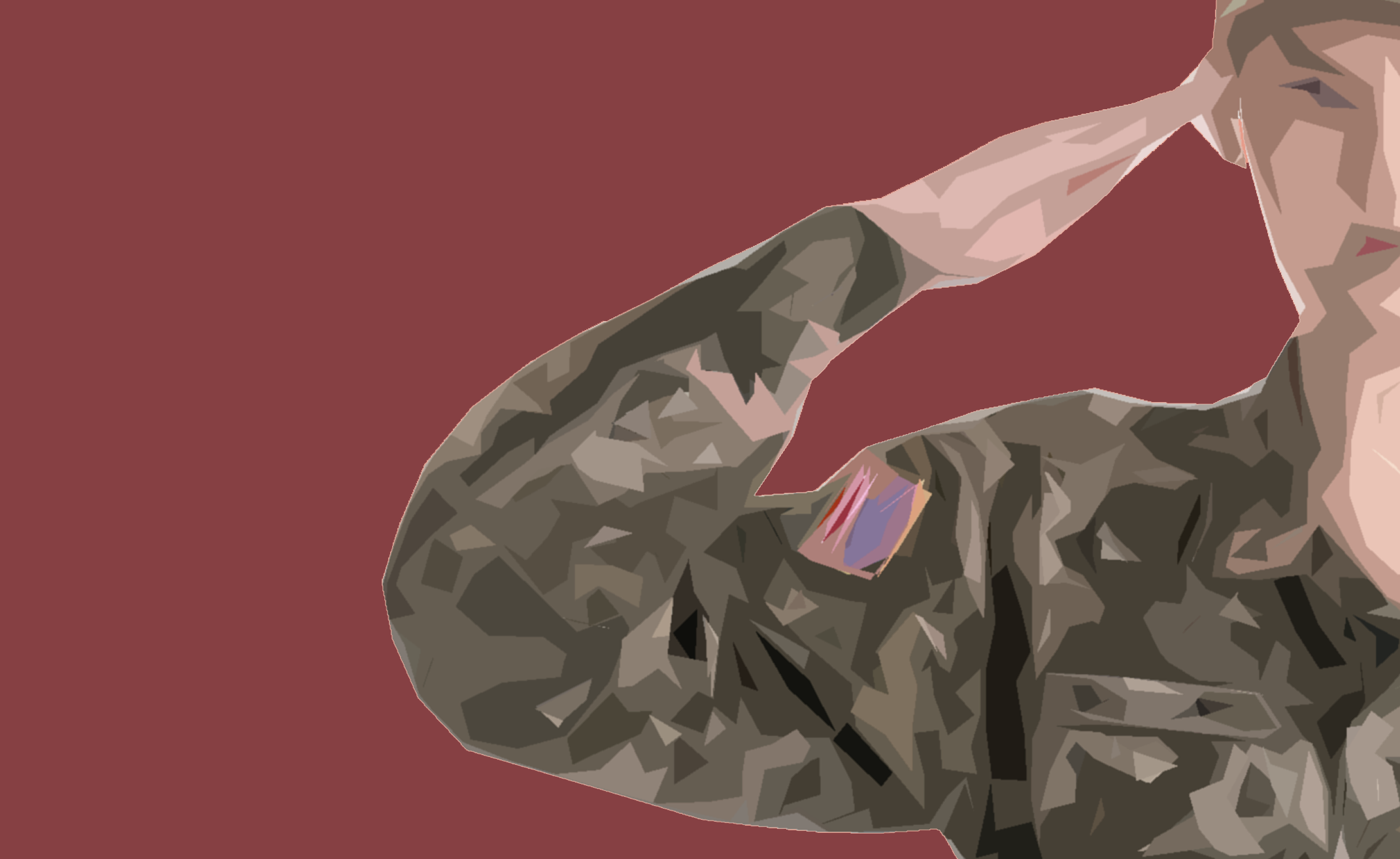Before sunrise, cadets and midshipmen are already awake, running laps at the Reflecting Pool or doing pushups on Georgetown’s front lawn as part of an arduous exercise regime. Being a member of the Reserve Officers’ Training Corps (ROTC) already demands a heavy training schedule and a series of professional commitments—but being in ROTC at Georgetown comes with its own hurdles.
Many Georgetown ROTC members, especially “crosstowners” in Navy and Air Force programs who commute for classes and trainings in D.C., report that a lack of administrative support and accommodations has made maintaining their schedules, which precariously balance ROTC requirements and Georgetown’s academic course load, unsustainable.
According to Sarah Bryant (NHS ’23), a midshipman in George Washington’s ROTC program, these difficulties have forced Georgetown’s ROTC students to rally together to get what they need. “The suffering of Georgetown [ROTC students] makes us closer as a unit.”
The Hoya Battalion is Georgetown’s Army ROTC program, which hosts students from Georgetown, George Washington University, American University, Catholic University, and the Institute for World Politics. Alongside GW’s Navy ROTC program and Howard University’s Air Force Detachment 130, the Battalion allows participating Hoyas to pursue four-year degrees while training to enter the military as officers.
While many assume that ROTC creates a binding commitment to service in the military, in reality, students may participate in an ROTC program for two years without incurring an obligation to serve. However, if students accept an ROTC scholarship from Georgetown, the cadets incur a four-year active duty commitment followed by a four-year inactive obligation. Reserve option cadets incur an eight-year commitment serving one weekend a month and two weeks a year.
Students can compete for the nearly 2,000 Army scholarships during their senior year of high school or they can join an ROTC program at a university and compete for campus scholarships. Navy scholarships fit into one of three categories: engineering programs of Navy interest, other engineering, math and science programs, or foreign language and other academic programs.
ROTC students have complained that this priority list does not accurately reflect the necessities of modern-day deployment, wherein cultural or linguistic knowledge about a region could be more essential in certain situations than mechanical engineering.
As part of each branch’s ROTC program requirement, students are mandated to take a set number of classes each semester separate from their graduation requirements. For Army ROTC, Georgetown offers nine military science classes over four years. Navy ROTC midshipmen also have a requisite list of classes that includes calculus and physics, in addition to naval science classes.
All naval science courses are held at GW, meaning students must allocate time in their schedule to make the roughly 10-minute commute by car to the Foggy Bottom campus. The weekly trip often occurs in the early mornings before the free Georgetown University Transportation Shuttle (GUTS) runs, and without a nearby Metro stop in Georgetown, students frequently have to get there by car. Even using GUTS as the primary method of travel adds nearly 40 minutes to the overall travel time.
According to Bryant, who is also the crosstown advocate for Navy ROTC students at GW, this often forces students to get together in groups to pay for their own transportation.
“If you just catch an Uber, it’s about $10, you split it with three or four other people, and you get there in 10 minutes,” Bryant said.
At roughly two or three dollars per trip each week, midshipmen and cadets might wind up paying nearly $100 on travel costs each year, and that’s only if the costs are split between a group. According to Bryant, there are several initiatives at Catholic University which reduce student difficulties in finding their way to classes early in the mornings, including using athlete transportation to facilitate ROTC travel to different universities—resources that are not available to Georgetown ROTC students.
While finding transportation to their military science classes is an expensive inconvenience faced by ROTC students, the more prominent hurdle is scheduling them in the first place. The strict course load students are required to maintain can place significant pressure on them during registration.
“The military science classes make my options very limited for the classes I can take,” Hoya Battalion cadet Matteo Caulfield (COL ’23) said. During his second semester, Caulfield was forced to enroll in overlapping classes to maintain his graduation trajectory, and had to skip one of the classes once a week to attend the other. “There weren’t a lot of options, and it was very frustrating that I had to be skipping classes and catching up on work outside of class when I already have ROTC.”
Other students have had similar experiences with registration. Matthieu Forgeas (SFS ’24) has had to push back several core requirements as a result of the program’s inflexibility.
“Generally, you can’t get into the sections on the days you need, so essentially you have to push core requirements back, which creates a mess, or you have to take a bunch of classes in a day,” Forgeas said.
At GW, this dilemma has been resolved by offering ROTC students pre-registration capabilities, but at Georgetown, the Academic Resource Council (ARC) only offers that ability to varsity athletes.
While ROTC students receive credit hours for their military science classes, after a certain point, those credits stop contributing toward any degree program—yet, students are still required to take the ROTC courses in order to enter the military as an officer. That leads to uncategorized credit hours and locks out opportunities to take other required degree courses or pick up another major or minor. The classification of different ROTC classes also varies, with a student’s school and dean determining which classes can go toward a specific degree, according to a university spokesperson.
At GW, the naval science credits that students earn can go toward a naval sciences minor, a program that is not offered at Georgetown.
Students like Grant Burroughs (SFS ’22) have been working for several months to change that. Burroughs, in his third year as an Army ROTC cadet, has been in contact with the SFS Academic Council and the Vice Dean for Undergraduate Affairs, Mark Giordano, in his attempts to bring a military science department to Georgetown.
“[The strict course load] leaves a lot of students unable to pursue other double majors, minors, certificate programs,” Burroughs said, speaking from personal experience. “We hope that a military science minor will allow ROTC students to receive credits for the classes they have been taking, but also for the larger Georgetown community in general,” he added. “A lot of students go into politics and government afterward, and this would allow them a foundation in how the military works and how it is a tool of foreign policy.”
Burroughs has been compiling a database of faculty who have expressed interest in a military science program and will continue seeking faculty support over the summer. The next step, Burroughs said, is to sit down with SFS academic deans, who will make the final decision.
Although the university has not yet taken action to establish such a program, administrators say they are open to expanding the scope of courses available.
“The university is supportive of exploring course and minor options that reflect our institutional values as well as the broad interests of our students,” the university spokesperson wrote in an email to the Voice.
The administration’s history with the Battalion and ROTC is long and tumultuous. The Battalion, although founded in 1830, had its roots during the Revolutionary War; George Washington was received at Georgetown and commended the students’ military qualities. During the Vietnam War, the ROTC program faced significant opposition from the rising anti-war protesters on campus, and as a result, the university discontinued academic credits for the program in line with student demands. Years later, the concessions were eventually lifted and the university gave the program its own academic department and senior cadets six credits.
Though the ROTC’s existence at Georgetown is now cemented, its members still experience hurdles in obtaining resources. For instance, students have sought access to physical trainers for decades to no avail. Access to physical trainers is granted to varsity athletes and many club sports, but according to Burroughs, the ROTC students’ physical training is just as demanding.
ROTC students have training anywhere from three to five times a week, with field training exercises on weekends three to four times a semester. “We have very rigorous demands. A lot of times, students will get injured, and we are forced to go to the Student Health Center, since it’s convenient and cheap and a good option, but they don’t have the physical trainer capabilities that we might need,” Burroughs said. He recounted being misdiagnosed by doctors at the center several times.
Lack of access to the athletic gyms and the varsity training center has also arisen as a point of discussion among ROTC students.
“It’s a pretty common mantra among ROTC cadets: ‘We should have access to the athletic gyms,’” Caulfield said.
Cadets currently make the best out of public spaces, like Duke Ellington Track and Field, Yates Field House, the front lawn of the university, or even the infamous Exorcist steps.
Yates, which cadets use in the winter when temperatures drop, presents its own limitations. Only certified trainers are allowed to “train” others, prohibiting ROTC groups from working out or running on the track as a collective.
This is only complicated further considering the Hoya Battalion consists of a consortium of schools. Graduates who are attached to the ROTC unit, often not Georgetown students, might have to pay out of pocket for a guest pass to use the campus facilities. According to Burroughs, access to an actual weight room would be a significant improvement over the body weight exercises cadets do outside.
“I understand a lot of the logistical problems that come along getting access to [the varsity training center], but it definitely would help with our training,” Burroughs said.
While many of these problems became less timely when students transitioned online, other difficulties for group training arose during the pandemic. ROTC students were initially part of the 2,000-person cadre that was set to return in the fall, in part thanks to GUSA advocacy, but when that number fell to 500, they were not included. Officers had to develop exercise programs compatible for their living room at home and do their best to adapt.
Many students decided to lease off-campus housing in D.C., where Caulfield says some members still gather outside in public spaces to go through exercises. For the spring semester, the program developed an optional in-person component to training on Tuesdays and Thursdays at the National Mall or the waterfront. Some students even fly out for the in-person weekend field training exercises that have continued. However, much of the camaraderie and accountability that comes from training alongside one’s ROTC class on a frequent basis was lost, according to Forgeas.
“It makes it a lot more bearable to run alongside your fellow midshipmen than doing all of the miles and pushups alone,” he said.
There are several other aspects to ROTC training that don’t translate well into an online environment, Caulfield noted. Teaching exercise forms, completing weapons training, participating in military ethics games, and even learning military mannerisms—which range from marching formations to the variety of salutes and greetings—are significantly more difficult, if not impossible, online, according to several ROTC members.
Similarly, each semester, cadets take three to four trips to Quantico—a small town in Virginia home to one of the largest U.S. Marine Corps bases, the Basics School, and the Officer Candidates School—in order to conduct battle drills and leadership exercises in combat situations, all of which are difficult to teach over Zoom.
“They have virtual training exercises where they give people tests on how land navigation works or how to give first aid in a combat zone, so they have something, but they’re losing really important parts,” Caulfield said.
According to Forgeas, the ROTC students will essentially have to repeat this year of training. At the end of August, midshipmen participate in a week-long bootcamp, and the ROTC students, despite being in their second year, will have to repeat the bootcamp in-person to replace the online training that occurred this year.
As the third and likely last online semester wraps up, student advocacy for a variety of initiatives, from ROTC pre-registration to a military sciences department, will only continue. Many student advocates in the ROTC program see the transition back to in-person education as the time to seize the opportunity for change.
Considering Georgetown’s emphasis on politics and public service, Caulfield is surprised by the limited accommodations for its ROTC students.
“It is so strange that they don’t support people who are in a program dedicated to putting themselves in public service and offering them the resources they have at their disposal to put them in the place they need to be,” Caulfield said.




